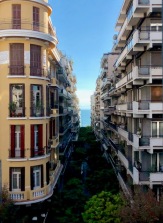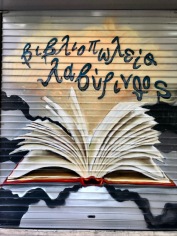10/18/18
ATHENS AND THE PELOPONNESE
One thing required for a trip like this is a lot of office time to plan for what’s next. I literally spent all of last summer preparing for this trip, especially for the Greek part of it. I spent much of this week on my computer in our apartment in Athens getting ready for the next two weeks and also the next two months in Italy. Ellen continued her heroic effort of tying down the logistics of everything. This is really a team effort! In between office hours we continued to photograph.
One day was spent at the remarkable state-of-the-art Conservation Lab at the National Library of Greece. I love places like this because there is so much physical stuff to photograph.
We also had two evenings with remarkable groups that are dealing with Athens’ homeless and refugee populations. The first was a mobile library staffed by a group of women volunteers. We met them in a dilapidated “artists squat” that they shared with a van providing a free mobile laundry for the people living on the street. One woman said that Athens has a big drug problem and we saw a street full of junkies shooting up as we drove away in their van at night.
The next night we went to an opening for a new library/center for refugees and homeless sponsored by a group called We Need Books. The Mayor’s Office helped with this project and we got to meet the Mayor before he gave a little speech to the large crowd. The DJ blasting tunes gave a feel of an art opening in the Mission District in San Francisco. It was a stark contrast with the rough neighborhood we were in.
We also met with three remarkable people this week: Artemis Zenetou – the head of the Greek Fulbright in Athens, Ioannis Trohopoulos – former head of the Veria Library and also the former head of the Niarcos Foundation Cultural Center, and Ioanna Nissiriou – the head of We Need Books. We are lucky to know these amazing Greeks.
Finally, we photographed the beautiful Gennadius Library. It was established in 1926 with funding from the Carnegie Foundation (yes, that Carnegie). It contained a remarkable exhibit by a contemporary Greek artist Antonious, about the 19th century German archeologist, Heinrich Schliemann, who discovered Troy and made major discoveries at Myceane. He spoke 19 languages and this exhibit was using his words as art. It felt very appropriate for this historic library to show this exhibit re-interpreting words from the past.
Our next week was back on the road again. The Peloponnese is steeped in history and contains several really great libraries. Corinth was where St. Paul unsuccessfully tried to convert the natives to Christianity. Ancient Corinth was master of this part of the world in the 6th Century BC and today the site called “Ancient Corinth” is spectacular.

The modern Corinth library is very active. We watched a short video made about the library that included the librarian’s son playing really good guitar. After they served us delicious Greek coffee we had fallen in love with this library. As always, it is the quality of the people working there that make this place special.
After a brief stop at the historically famous Corinth Canal we headed on to the city of Argos. Sadly, the library was closed and the outside looked like it had seen better days. We will have to find out why. We ended the day at the pretty coastal city of Nafplio. We stayed in a pension in the old town with attractive narrow streets, elegant Venetian houses and an interesting library. It reminded me of a smaller version of Corfu Town without the tourists.
The Nafplion Library is another example of a generous benefactor endowing the city with his collection of books. In this case, to begin the first high school in Greece in the 1830’s. The books are now in the library and this seems like a well- loved place.
For the rest of the day we went back several thousand years to visit two ancient sites: Ancient Mycaene and Ancient Epidavros which consists of the spectacular Theatre and the Sancturary of Asclepius. Mycenae has many tourists, especially near the famous Lions Gate. But it is so spread out that we find ourselves being able to contemplate in solitude the vast distance of time that separates us from this place and culture. The underground cistern is especially interesting. It’s all about water!
The Theatre of Ancient Epidavros is the best-preserved structure of this scale from the ancient world. Literally, one can drop a coin on the stage and you can clearly hear it at the top seats of the 14,000-seat theater. The Sanctuary is also impressive and is considered one of the birthplaces of Western medicine and healing. Travel is a great teacher and all these sites today were a revelation.

The next morning after a several-hour drive we enter the beautiful and steep Arcadian Mountains. Our goal was a library in the tiny mountain town of Andritsena. After a gazillion hairpin turns on a tiny mountain road we came to the Public Historic Library of Andritsena. This one is a gem. Established in 1840, it is one of the most important historic and richest libraries in the country. It is housed in a neo-classical building built in 1879. A Greek ex-pat of staggering intelligence and no money living in Paris somehow gathered together one of the largest privately held libraries at the time. He donated his collection of books to his father’s home town. He planned to move there with his library but while cleaning the books he got a paper cut and later died from infection. The books eventually arrived in Naplion but sat there for decades because of unpaid bills. Years later they finally arrived in this tiny mountain village. We are met by the President of the Board and his wife. After a wonderful overview of this romantic place I have just a few hours to photograph this amazing library. The library even contained replicas of carvings stolen by the British in the 19th Century from a nearby ancient Greek temple. As we head to our apartment I am amazed that such a really small town could have such a really great library.
So as to not waste any time we rush off again on even smaller mountain roads to the very remote ancient site of the Temple of the Epicurean Apollo at Vasses. This is another extraordinary place and we are the only people there! High in the Arcadian Mountains I feel like we are the edge of the world. This UNESCO World Heritage temple was completely covered and was in the process of being stabilized and restored. The tenting and an artist’s soundtrack playing in the background added greatly to the surreal experience of photographing this crazy interesting place. I had 20 minutes to photograph before they closed and I was exhilarated when I finished. Some places are just very special and this was one of them.


As we drove back at dusk we saw incredible vistas and a shepherd and many goats and dogs on the spaghetti-like road. We head back to Andritsena and go to dinner. As I was driving down the one street in town we spot a tiny café and a woman who comes out and invites us in. It is where the locals eat (not the tourists) and we thoroughly enjoy our meal. The TV news is on and when Trump’s face appears on the screen I instinctively cover my face. When I look up at the Greeks in the café they are all smiling and nodding at me in approval. This is a moment of cross-cultural connection. At breakfast the next morning I spotted a large black and white photograph of a shepherd girl spinning wool in front of the Temple of Epicurean Apollo that we had just visited. The owner of the café explained that the girl in the photo is her mother. She had fond memories of playing in the rubble of the Temple before it was turned into a World Heritage site. I gain a small insight into the transformation of this small community. It also represents something of the larger transformation of Greece today and its relation to its near and ancient past.

































































